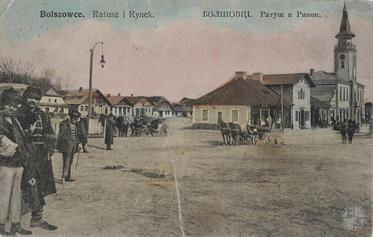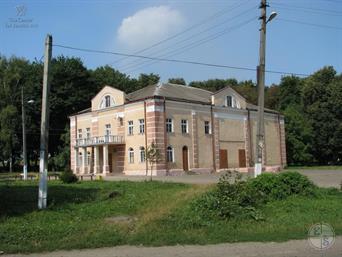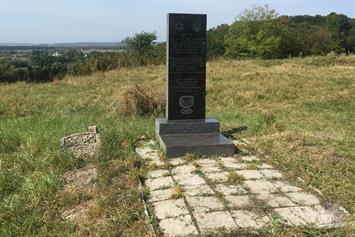Bilshivtsi
Sources:
- Russian Jewish encyclopedia
- Jewish encyclopedia of Brockhaus & Efron
- Virtual Shtetl. Bołszowce
- Holokost na tierritoryi SSSR. Entsiklopedya, Moscow 2009, p. 97.
Photo:
- Vladimir Levin, Center for Jewish art
- Jewish Cemeteries Initiative. Bilshivtsi Jewish Cemetery
- Biblioteka Narodowa Polona. Bołszowce
- Russian Jewish encyclopedia
- Jewish encyclopedia of Brockhaus & Efron
- Virtual Shtetl. Bołszowce
- Holokost na tierritoryi SSSR. Entsiklopedya, Moscow 2009, p. 97.
Photo:
- Vladimir Levin, Center for Jewish art
- Jewish Cemeteries Initiative. Bilshivtsi Jewish Cemetery
- Biblioteka Narodowa Polona. Bołszowce
Ivano-Frankivsk district, Ivano-Frankivsk region
Bilshivtsi, urban-type settlement (since 1940) in the Ivano-Frankivsk region.
Known from the 15th century. In 19 - beginning of the 20th century - in the province of Galicia in Austria-Hungary. In 1919–39 - as part of Poland, in 1939–91 - USSR.
In 1765 in Bilshivtsi lived 178 Jews,
in 1880 - 1760 (60%),
in 1890 - 2658 (76%),
in 1900 - 2256 (57% ),
in 1910 - 2438 (53%),
in 1920 - 825 (38%),
in 1931 - approx. 1200 Jews.
Known from the 15th century. In 19 - beginning of the 20th century - in the province of Galicia in Austria-Hungary. In 1919–39 - as part of Poland, in 1939–91 - USSR.
In 1765 in Bilshivtsi lived 178 Jews,
in 1880 - 1760 (60%),
in 1890 - 2658 (76%),
in 1900 - 2256 (57% ),
in 1910 - 2438 (53%),
in 1920 - 825 (38%),
in 1931 - approx. 1200 Jews.
First Jews settled in Bołszowce (currently Bilshivitsi) in 1635. The earliest data on the size of the community dates back to the second half of the 18th century. In 1765, 178 Jews lived in the town. The local religious community was established at the end of the 18th century.
In the 19th century, Jews constituted the majority of the inhabitants of Bilshivitsi.
At the end of the 19th century, the rabbi of Bołszowce was Zeev Hammer, succeeded by Shymon Gotesman in the early 20th century.
The beginning of the 20th century marked the emergence of first Zionist organisations in the town, including B’nai Zion (Sons of Zion). At the time, 70% of local Jews were involved in small trade, 22% – in crafts, and 3% – in agriculture.
During World War I, most Jews left the town. In 1921, Bilshivitsi had 825 Jewish inhabitants (37.7%). In the interwar period, their number again increased to ca. 1,200 people in 1931 and 1,450 in 1939 (37.2%).
At the end of the 1920s, Szlomo Kaper became the local rabbi. He performed this function until the outbreak of World War II.
In the interwar period, many Jewish social and cultural organisations operated in Bołszowce. The town also boasted a Tarbut school and a Jewish bank.
In the 1930s, thanks to financial assistance received from the American Joint Distribution Committee, a Jewish provident fund was established.
In the 19th century, Jews constituted the majority of the inhabitants of Bilshivitsi.
At the end of the 19th century, the rabbi of Bołszowce was Zeev Hammer, succeeded by Shymon Gotesman in the early 20th century.
The beginning of the 20th century marked the emergence of first Zionist organisations in the town, including B’nai Zion (Sons of Zion). At the time, 70% of local Jews were involved in small trade, 22% – in crafts, and 3% – in agriculture.
During World War I, most Jews left the town. In 1921, Bilshivitsi had 825 Jewish inhabitants (37.7%). In the interwar period, their number again increased to ca. 1,200 people in 1931 and 1,450 in 1939 (37.2%).
At the end of the 1920s, Szlomo Kaper became the local rabbi. He performed this function until the outbreak of World War II.
In the interwar period, many Jewish social and cultural organisations operated in Bołszowce. The town also boasted a Tarbut school and a Jewish bank.
In the 1930s, thanks to financial assistance received from the American Joint Distribution Committee, a Jewish provident fund was established.
In September 1939, Bołszowce came under Soviet control, but on 3 July 1941, the town was seized by German troops. A round-up was carried out shortly afterwards, in which 450 Jews were captured and murdered.
Germans ordered the captives to kneel down and go to the execution site, located 5 km from Bilshivitsi, on their knees. Those unable to keep up were beaten; the elderly who could not walk any longer were shot on the way. The operations aimed at liquidating the Jewish population were carried out under the command of Commandant Miller and his deputy, Reichenfatcher.
Bilshivitsi became part of the Halych Municipality in the Stanisławуw (currently Ivano-Frankivsk) County of the General Government. The Germans created a ghetto in the town. At the same time, they confiscated food from Jews, which immediately resulted in widespread hunger.
On 21 September 1942, 200 people from the ghetto were deported to the Nazi German death camp in Belzec.
On 25 October 1942, 1,150 Jews were captured by Germans and deported from Halicz (Halych) to Belzec on the following day (according to other sources, this happened on 14 March 1942; 1,380 Jews were deported from Bołszowce and the village of Słobidka Bilshovetska).
The remaining 400 Jews were ordered to move to Rohatyn within three days. Some died in Rohatyn, while most were deported to the death camp in Belzec on 8 December 1942.
According to the data of the Extraordinary State Commission, a total of 1,831 Jews were killed in the today’s Bilshivitsi district.
Germans ordered the captives to kneel down and go to the execution site, located 5 km from Bilshivitsi, on their knees. Those unable to keep up were beaten; the elderly who could not walk any longer were shot on the way. The operations aimed at liquidating the Jewish population were carried out under the command of Commandant Miller and his deputy, Reichenfatcher.
Bilshivitsi became part of the Halych Municipality in the Stanisławуw (currently Ivano-Frankivsk) County of the General Government. The Germans created a ghetto in the town. At the same time, they confiscated food from Jews, which immediately resulted in widespread hunger.
On 21 September 1942, 200 people from the ghetto were deported to the Nazi German death camp in Belzec.
On 25 October 1942, 1,150 Jews were captured by Germans and deported from Halicz (Halych) to Belzec on the following day (according to other sources, this happened on 14 March 1942; 1,380 Jews were deported from Bołszowce and the village of Słobidka Bilshovetska).
The remaining 400 Jews were ordered to move to Rohatyn within three days. Some died in Rohatyn, while most were deported to the death camp in Belzec on 8 December 1942.
According to the data of the Extraordinary State Commission, a total of 1,831 Jews were killed in the today’s Bilshivitsi district.

- Home
- Shtetls
- Vinnytsia region
- Volyn region
- Dnipro region
- Donetsk region
- Zhytomyr region
- Zakarpattia region
- Zaporizhzhia region
- Ivano-Frankivsk region
- Kyiv region
- Kropyvnytskyi region
- Luhansk region
- Lviv region
- Mykolayiv region
- Odessa region
- Poltava region
- Rivne region
- Sumy region
- Ternopil region
- Kharkiv region
- Kherson region
- Khmelnytskyi region
- Chernihiv region
- Chernivtsi region
- Cherkasy region
- Crimea
- Synagogues
- Cemeteries
- Objects & guides
- Old photos
- History
- Contact
Jewish towns of Ukraine
Jewish towns of Ukraine
My shtetl
My shtetl
Donate


